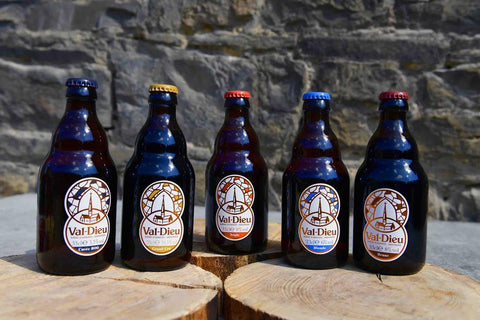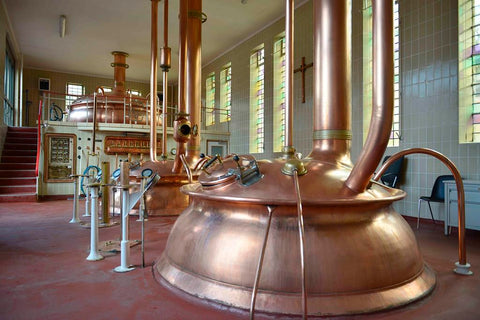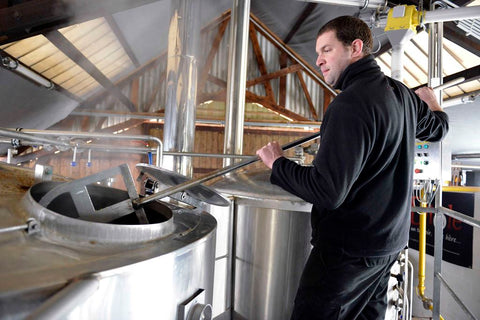- No products in the cart.
Brasserie d'Orval

The Beginning – Dig a little into the origins of this famed Trappist abbey, and you'll find that its name says it all. Orval is the ‘golden valley’ – or val d’or – lying on the ancient Roman road between Reims and Trier. And the religiously-minded have long gravitated to the secluded forests of the Gaume valley.
In fact, the first religious communities to set-up here were the Cistercian monks, who arrived between 1070 and 1132. Orval was to be the fifty-third abbey founded by that order of monks, to which all of today's Trappists also belong.
It's thought that it was the clear spring water, that bubbles up here, that drew those first monks to this particular spot. That ancient spring also became the font of Orval's later fame – in common with most Cistercian abbeys, the monks of Orval started brewing their beer using its crystal waters.
The current abbey, by comparison, is less than one hundred years young. In 1793 the French Revolution put to an end to seven centuries of its previous religious history. Today, the ruins of the original 12th-century medieval abbey provide an impression of life and work for the monks during those pioneering years. Perhaps most striking is the difference in its size. The medieval abbey is dwarfed by the 20th-century replacement.
It itself is built on the foundations of the 18th-century complex that was razed to the ground, during the French Revolution. Orval’s second life started in 1926. The de Harenne family, owners of the land at the time, ceded the domain back to the Cistercians.
Twenty years’ of building work ensued, aiming to raise up what would become something of a monumental abbey. The Trappist brothers even purchased the entire Pas-Bayard quarry – in the French department of Meurthe-et-Moselle – to make real their vision. From it they extracted some 7,000 cubic metres of sandstone.
The Orval abbey you'll find today is a monument fashioned in the neo-Roman style, inspired by the Burgundian Fontenaye Abbey. The leaded windows of the abbey church present fine examples of religious art from the 1930s. However, more secular influences can also be detected.
The art deco style, practiced by architects such as Henri Van de Velde, has left its traces. Architect Henri Vaes drew up the plans for both the abbey and the brewery, and also designed the abbey's iconic chalice and striking architectural stylings.
The brothers here have opted for communal living, their lives are following an ageless rhythm of meditation, prayer and work. Today, just as in the 11th-century, several times a day the abbey resounds with the brothers’ liturgical chants. In between these services, the silence is deafening. Except, perhaps, for a bubbling in the brewery..
The Brewing

Orval has always been the odd one out amongst Trappist abbey-breweries. Right from the start, the monks here decided to pass over their beer-making activities to lay-brewers. That's because beer wasn't to be incidental to their efforts to raise-up a new abbey – it was to be central to them.
To that end, Orval became the first Trappist beer marketed and sold throughout Belgium. And it was actually the brewery, only completed in 1931, that funded much of the abbey's rebuilding work.
The first brew-master was a German, one Hans Pappenheimer. He launched Orval's Trappist beer in 1932. But with the success of the beers of fellow Trappists Chimay, post-war, Orval looked to their brethren for advice on how to advance their own brews. In the 1950s, two of Orval's own, Brother Dominique and Father Raphaël, were apprenticed to Brother Théodore in Chimay.
Professor Jean Declerck, Chimay's adviser from Leuven, also recommended that the brewing facilities at Orval be adjusted, which resulted in a changed brewing method.
But it was Brother Dominique who first managed to isolate the wild yeasts that were characteristic of pre-war Orval. Louvain-la-Neuve University are now responsible for cultivating the two strains of wild yeast that are added to the Orval brew, after its main fermentation.
Another noteworthy aspect of this Belgian beer classic is the use of the very English technique of ‘dry hopping’. This is where a bag, made from a finely-meshed material and containing hop flowers, is added to the tank to produce an better bittering infusion.
And Orval beer is certainly on the bitter side for a Trappist, and quite dry too. But the wild yeasts working within this brew do give it a characteristic sourness, though, a slightly acidic touch that is especially noticeable six months after brewing.
Today, the entire brewing process takes nine weeks, as Orval is only really considered ready to drink when those wild yeasts have finished their work. So the bottles will usually rest for five weeks, to ensure that the in-bottle fermentation is in full swing.
Beer-lovers from ‘le pays d’Orval’, in the Ardennes and Gaume regions, will often wait another six months before cracking open their ‘vieil Orval’. Good flavours come to those who wait; especially where a brewing legend is concerned. Orval is certainly best-known as a degustation beer – suitable for use as both an aperitif, as well as a digestive. For maximum enjoyment, keep well clear of the fridge, and drink this beer at room temperature (12 to 14°C).
The Brewers

Orval has seen something a generation – and gender – shift at the top of its brewing team recently. The brewery had been managed by respected brew-master Jean-Marie Rock since 1985. But in 2013, he handed over the mashing stick to his right-hand woman, Anne-Françoise Pypaert. She is the first woman to assume responsibility at the head of a Trappist brewery.
Over the (nearly) three decades that he was in charge, Jean-Marie Rock was able to make continuous improvements to the quality of the beer – with careful tweaking of the time-proven Orval brewing process.
Orval is dry-hopped using Yakima Tomahawk and Hallertauer aroma hops, and dry-hopped again with Styrian Golding hop bells. The English influence on the abbey's only brew goes beyond the use of dry hopping, though. For the main fermentation (of some five days), the strain used actually originates in England.
The yeast is most important to Orval's taste profile, being responsible for the noted fruitiness of the beer. A new secondary ferment yeast culture is started every five weeks, using a strain grown in the university lab of UCL in Louvain-la-Neuve. This cultivated Brettanomyces culture, well-known from the lambiek beers, is only added just before bottling. Significantly, though, it takes those Brettanomyces a considerable time before they start converting all the remaining sugars into alcohol and carbon dioxide.
That tardiness results in a beer that is very dry during its first three months. It's only after that time that the wild yeasts set to work, and Orval starts attaining the typical sour touch of oude geuze.
Anne-Françoise Pypaert thinks that the beer is at its best around the six month mark, when there isn't yet any oxidation from aging. But if you fancy an insight into the beer's taste evolution, the abbey tavern provides just such an opportunity. At L’Ange Gardien you can taste the freshly-poured – green – Orval, which is the beer that the monks drink as well. This ‘refectory beer’ is a strictly limited experience, though – it can only be obtained at the inn.
The Beers
The Visit

As is the case with all the Trappists, tours of the brewery itself are not on offer at Orval abbey. There is a mystique to preserve, after all. However, a visit to Orval is still amply rewarded. There's a whole host of activities, and a wealth of experience and information, provided onsite for the curious visitor.
Among the attractions are a walking trail criss-crossing the grounds, with information signs; the brewery museum; a traditional apothecary; and the abbey's herb garden full of medicinal plants. There's also an interactive trail for children, an exhibition of the works of the monk-painter Brother Abraham Gilson, and even a tactile scale-model of the abbey for the sight impaired.
The Orval Museum does a great job of depicting the history of the abbey, and its famous brew. The early chapters of Orval's story are covered – including some of the first Trappist beer-marketing materials. Art deco objects have been put on display, serving to remind of the artistry involved in advertising 'back-in-the-day'. You can also find out more about the craftsmanship involved in the brewing of Orval, while an audio-visual presentation that covers the abbey’s history and monastic life.
The L’Ange Gardien tavern was designed by Henry Vaes, and is 'decked-out' in the art deco style. Its name comes from the works of the Countess of Ségur, who wrote a number of much-loved French fairy tales.
One of these was entitled 'The Inn of the Guardian Angel' – or L’Ange Gardien. In L’Ange Gardien you can taste the abbey's ‘petite bière’, a lighter, younger version of Orval beer consumed by the monks. You can also try the water from the Mathilde fountain in specially designed drinking glasses.
Visit the ruins of the old Cistercian abbey, and you'll discover a site with a captivating history and a very special beauty. It nestles in the valley where the spring-waters used for the beer still well up – the Mathilde Fountain. And while there, don't neglect to visit the grave of Count Wenceslas of Luxembourg, which lies among the crumbling abbey walls.
The Location
.jpg?1392830210)
Orval really does deserve its reputation of being an 'oasis of peace, in a sea of green'. The monks couldn't have dreamed of a more perfect surrounding for spiritual seclusion and meditation. Their imposing abbey, tucked against the French border in the far south of Luxembourg province, is surrounded by over three thousand hectares of forest.
The nearest town of Arlon is nearly thirty miles away. But historical evidence from times long-past indicate that this region hasn't always been such an isolated one. For example, Orval is home to the ruins of a Roman relay station, that was situated on the former army road between Reims and Trier. This road was constructed to enable swift movements by Rome's legions. Relays were placed at regular distances to allow the couriers to change horses.
Beyond the long reach of its history, and its undoubted natural beauty, the area around Orval also has some surprises. One of these is the village of Torgny, close to Virton, about half an hour away from Orval. It's the most southerly village in Belgium, and with its south-facing slopes, and sheltering woods, it enjoys its own wonderfully mild micro-climate.
Torgny could also be a little slice of the Mediterranean, complete with its vineyards and charming tiled houses. The cottages, with their golden yellow sandstone walls and red-brick roofs, certainly wouldn't be out of place in the Provence. It was once traditional to plaster these walls with a mixture of chalk and sand (‘chaume’), adding colourings (ochre, beige, pastel) to protect them from damp and frost.
That's not done so much these days, but these characteristic Torgny buildings – with their protuberant windows and door frames, and part-curved lintels – are most certainly worth the short jaunt down here to see.
Getting There & Around

Orval is, unfortunately, not particularly easy to reach using public transport: the best way to get to the abbey is still the car. That auto-journey from Brussels takes just over two hours, depending on traffic. Take exit 27 (Longlier/ Neufchâteau) off the E411 Namen (Namur) -Luxembourg motorway. Head along the N88, in the direction of Florenville-Virton, until you reach Château d’Orval.
You'll then need to follow the signs for ‘Villers-devant-Orval’, driving through the forest for around eight kilometres. The road then descends towards a small river – you need to turn left just before the bridge. Follow this road until you pass ‘l’Ange Gardien’, and you'll have arrived at Orval.
Those who are brave enough to accept the public transport challenge should travel by train to the nearest station, Florenville. At a distance of 9 kilometres from the abbey, you still have considerable walk (or cycle) ahead of you.
So you may decide you're better off taking the bus from the train station. If you are staying in the region, though, consider hiring a bicycle. Not only will it get you from station to abbey, it's a stress-free way of exploring Orval and its surroundings. This relatively unrushed region is well-suited to cycle trips.
Gastronomy, Food & More Beer

Quality is foremost in all things for Orval, especially when it comes to those entrusted with the pouring of its beers. So the brewer does its best to ensure that cafés offering Orval know how to pour it in the correct manner. After anonymous inspections, an elite few – around two hundred cafés annually – are recognised as meeting the requirements of being ‘Orval ambassadors’.
In such establishments you can be assured that the beer is poured slowly and into the correct glass. According to Orval's rules, the beer is poured in one continuous movement, so that the residues are not disturbed.
The Gaume and Semois region isn't just famed for beer – its beef is also reputed. The region has recently introduced a new quality label for beef: Le boeuf des prairies gaumaises. It guarantees that the animals are reared locally, and only fed on grass and hay.
The result is ox beef that has a very delicate taste, marbled with fat, tender and deep red in colour. Almost a dozen cattle breeders are united by this label that aims to promote sustainable agriculture. This ox beef is usually on sale locally from November to March. Here in Orval, though, you are on a culinary divide – the border between the Ardennes and the Gaume.
So there are subtle difference between the regions, as shown by their charcuterie. Sausage from the Ardennes is drier; in the Gaume the meat is given a slightly shorter time to mature.
In nearby Habay-la-Neuve you will find a butcher, André Thomas, who produces span that divide: Ardennes ham, 'pâté gaumais' and sausages from across the region. A good sausage must be given time to mature and dry out, André feels. Somewhat like a beer, you could say.
More Info
Tourism for Semois and Gaume:
Maison du Tourisme du Pays de la Semois entre Ardenne et Gaume
Esplanade du Panorama, 1
B-6820 Florenville
Tel: +32 (0) 61 / 31 12 29
Website: www.semois-tourisme.be
Tourism for Luxembourg Province:
Toeristische Federatie Provincie Luxemburg
Quai de l’Ourthe 9
B-6980 La Roche-en-Ardenne
Tel.: +32(0) 84 / 41 10 11
Website: www.ftlb.be
E-mail: info@ftlb.be
Contact

Abbaye Notre Dame d’Orval
Orval, n° 2
B-6823, Villers-devant-Orval
Orval, n° 2
B-6823, Villers-devant-Orval






